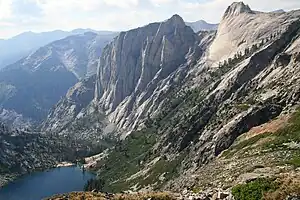Mount Le Conte (California)
Mount Le Conte (or LeConte) is a mountain located in the Sierra Nevada of California. The boundary between Inyo and Tulare counties runs along the crest of the Sierra, across Mount Le Conte. The mountain was named in 1895 for Joseph Le Conte (1823–1901), the first professor of geology and natural history at the University of California.[6]
| Mount Le Conte | |
|---|---|
 Mount Le Conte from Boreal Plateau. | |
| Highest point | |
| Elevation | 13,936 ft (4,248 m) NAVD 88[1] |
| Prominence | 1,003 ft (306 m)[1] |
| Parent peak | Mount Whitney[2] |
| Listing | |
| Coordinates | 36°32′27″N 118°15′07″W[5] |
| Geography | |
 Mount Le Conte | |
| Location | Inyo and Tulare counties, California, U.S. |
| Parent range | Sierra Nevada |
| Topo map | USGS Mount Whitney |
| Climbing | |
| First ascent | July 1925 by Norman Clyde[6] |
| Easiest route | Exposed scramble, class 3[7] |
Geography
Mount Le Conte is about 3.5 miles (5.6 km) southeast of Mount Whitney, and is flanked to the northwest by Mount Mallory, and to the southeast by Mount Corcoran.
The southwest side of Mount Le Conte drains into Rock Creek, thence into the Kern River, which ends in the Central Valley of California. The north side of Mount Le Conte drains into Meysan Creek, thence into Lone Pine Creek, which ends in the Owens Valley. The east side of Le Conte drains into Tuttle Creek, and thence into Diaz Lake in the Owens Valley.
The southwest side is in Sequoia National Park while the north and east is in the John Muir Wilderness of the Inyo National Forest. The Pacific Crest Trail enters the park from the south at Siberian Pass about 5 miles (8.0 km) south of Mount Le Conte, and runs through the park a few miles west of the Sierra Crest.

See also
References
- "Mount LeConte, California". Peakbagger.com. Retrieved 2011-06-01.
- "Arc Pass". Peakbagger.com. Retrieved 2016-03-23.
- "Sierra Peaks Section List" (PDF). Angeles Chapter, Sierra Club. Retrieved 2008-12-29.
- "Western States Climbers Qualifying Peak List". Retrieved 2016-03-24.
- "Mount Le Conte". Geographic Names Information System. United States Geological Survey, United States Department of the Interior. Retrieved 2009-01-01.
- Farquhar, Francis P. (1926). Place Names of the High Sierra. San Francisco: Sierra Club. Retrieved 2007-08-12.
- Roper, Steve (1976). The Climber's Guide to the High Sierra. San Francisco: Sierra Club Books. p. 321. ISBN 978-0871561473.
